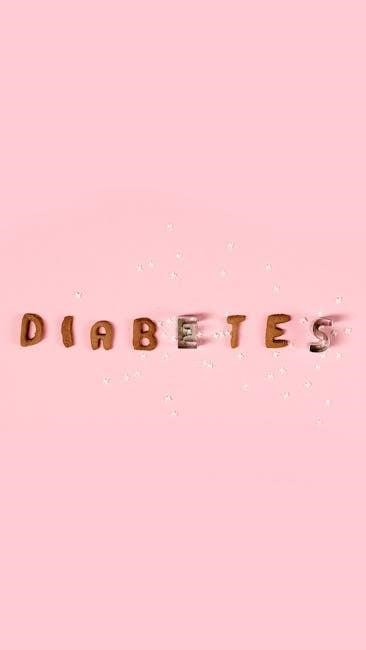The Celiac Disease Foundation offers a Pediatric Meal Plan and a Quick Start Guide to help individuals adopt a gluten-free diet. These resources provide essential information on managing celiac disease through dietary adjustments, ensuring a healthy and balanced lifestyle. The 4-Week Tasty Gluten-Free Meal Plan is also available for download as a PDF, offering practical meal ideas and shopping tips.
What is Celiac Disease?
Celiac disease is a chronic autoimmune disorder triggered by the ingestion of gluten, a protein found in wheat, rye, and barley. It causes the immune system to damage the small intestine, impairing nutrient absorption. Symptoms include digestive issues, fatigue, and malnutrition. If untreated, it can lead to complications like anemia and osteoporosis. The only treatment is a strict, lifelong gluten-free diet, which allows the small intestine to heal and manage symptoms effectively. Celiac disease is also known as celiac sprue and is linked to genetic predisposition and other autoimmune conditions, such as type 1 diabetes and thyroid disease. Early diagnosis and adherence to a gluten-free diet are crucial for long-term health and well-being.
The Importance of a Gluten-Free Diet
A gluten-free diet is the only treatment for celiac disease, as it prevents damage to the small intestine and promotes healing. Without it, chronic inflammation can lead to malnutrition, anemia, and osteoporosis; Adhering to this diet is essential to manage symptoms, restore nutrient absorption, and prevent long-term complications. It requires careful planning to avoid gluten-containing foods like wheat, rye, and barley, while focusing on naturally gluten-free alternatives. The diet not only improves overall health but also enhances quality of life for individuals with celiac disease, ensuring they can thrive without gluten.
Overview of the Celiac Disease Diet Plan PDF
The Celiac Disease Diet Plan PDF provides a comprehensive guide for managing celiac disease through dietary changes. It includes detailed meal plans, shopping lists, and recipes tailored to a gluten-free lifestyle. The PDF offers a structured approach to nutrition, ensuring individuals with celiac disease can maintain a balanced diet. Resources like the Pediatric Meal Plan and the Quick Start Guide are designed to simplify the transition to a gluten-free diet. The plan covers essential topics such as identifying gluten-free foods, avoiding cross-contamination, and managing nutritional deficiencies. It is an invaluable tool for anyone diagnosed with celiac disease, offering practical advice to support long-term health and well-being.

Understanding the Gluten-Free Diet
A gluten-free diet is essential for managing celiac disease, focusing on avoiding gluten-containing grains like wheat, barley, and rye. The Celiac Disease Diet Plan PDF provides structured guidance, including meal plans and recipes, to ensure a balanced and nutritious lifestyle. It emphasizes the importance of reading food labels and identifying safe alternatives, making it a vital resource for those navigating a gluten-free diet. The plan also offers practical tips for avoiding cross-contamination and managing social challenges, helping individuals adhere to their dietary requirements effectively.
Foods to Avoid: Gluten-Containing Grains
Individuals with celiac disease must avoid gluten-containing grains, including wheat, barley, rye, and sometimes oats due to cross-contamination. These grains trigger an immune response, damaging the small intestine. The Celiac Disease Diet Plan PDF highlights the importance of eliminating these foods to manage symptoms and promote healing. It also provides clear guidelines on identifying gluten in various products and offers alternatives to ensure a balanced diet. Avoiding gluten-containing grains is crucial for long-term health and preventing complications associated with celiac disease. The PDF serves as a comprehensive guide, helping individuals understand which foods to avoid and how to make safe, nutritious choices.
Foods to Include: Gluten-Free Alternatives
A gluten-free diet focuses on incorporating naturally gluten-free foods and alternatives to ensure nutritional balance. Fresh fruits, vegetables, lean meats, fish, eggs, and dairy products are safe and essential. Gluten-free grains like rice, quinoa, corn, and millet are excellent substitutes. The Celiac Disease Diet Plan PDF provides detailed lists of gluten-free foods, including certified products. It also emphasizes the importance of reading food labels to identify gluten-free options. Incorporating healthy fats like nuts, seeds, and olive oil is recommended. This approach ensures individuals with celiac disease can maintain a diverse and nutritious diet, promoting overall health and well-being while adhering to gluten-free guidelines.
Reading Food Labels for Gluten
Reading food labels is crucial for managing celiac disease. Look for the “gluten-free” certification or symbols like the Gluten-Free Certification Organization (GFCO) mark. Always check ingredient lists for hidden gluten sources, such as barley, rye, triticale, or wheat. Be aware of terms like “modified food starch” or “hydrolyzed vegetable protein,” which may contain gluten. The Celiac Disease Diet Plan PDF provides detailed guidance on label reading, emphasizing the importance of avoiding cross-contamination. It also highlights certified gluten-free products, ensuring safety and compliance with dietary requirements. This step is vital to maintain a strict gluten-free diet and prevent accidental exposure to gluten.

Nutritional Considerations
A balanced gluten-free diet is essential for managing celiac disease. Focus on nutrient-rich foods, including fruits, vegetables, lean proteins, and whole grains like rice and quinoa. Ensure adequate fiber intake to support digestive health and prevent deficiencies. The Celiac Disease Diet Plan PDF provides guidance on maintaining proper nutrition while avoiding gluten, helping individuals thrive on a gluten-free lifestyle.
Key Nutrients in a Gluten-Free Diet
A gluten-free diet for celiac disease requires careful attention to essential nutrients to avoid deficiencies. Fiber is crucial for digestive health and can be found in fruits, vegetables, and gluten-free whole grains like brown rice and quinoa. B vitamins, especially folate and B12, are vital for energy production and nerve function. Iron and calcium are also important, as celiac disease can impair absorption. Incorporating lean proteins, healthy fats, and fortified gluten-free products helps maintain nutritional balance. Additionally, omega-3 fatty acids from fish and nuts support overall health. Probiotics can aid gut healing, while vitamin D supports bone health. A varied and nutrient-dense diet ensures optimal wellness for those with celiac disease.
Managing Nutritional Deficiencies
Managing nutritional deficiencies in celiac disease involves a tailored approach to ensure adequate intake of essential vitamins and minerals. Iron deficiency is common due to malabsorption, so increasing iron-rich foods like leafy greens and red meats is recommended; Vitamin B12 supplements are often necessary, as absorption issues may persist. Calcium and vitamin D are crucial for bone health, and fortified dairy or plant-based alternatives can help meet these needs. Zinc and magnesium, often lacking in gluten-free diets, can be boosted with nuts, seeds, and whole grains. Regular blood tests and consultations with a dietitian are vital to monitor nutrient levels and adjust the diet plan accordingly. This proactive strategy helps prevent long-term health complications and supports overall well-being.
The Role of Fiber in the Diet
Fiber plays a vital role in maintaining a healthy digestive system, especially for individuals with celiac disease. A high-fiber diet helps regulate bowel movements, prevent constipation, and promote the healing of the intestinal lining. Gluten-free whole grains like brown rice, quinoa, and millet are excellent sources of fiber. Fresh fruits, vegetables, and legumes such as lentils and chickpeas also contribute significantly to fiber intake. Incorporating these foods into the diet helps ensure proper nutrient absorption and supports overall gut health. It is important to gradually increase fiber intake to avoid digestive discomfort and to drink plenty of water to aid digestion.

Meal Planning Strategies
Effective meal planning involves creating structured daily and weekly schedules, utilizing shopping lists, and exploring resources like the Celiac Disease Foundation’s Pediatric Meal Plan and 4-Week Gluten-Free Meal Plan PDF for practical tips and recipe ideas to ensure a balanced and varied gluten-free diet.
Creating a Daily Meal Plan
Creating a daily meal plan is essential for managing celiac disease effectively. Start by balancing macronutrients and incorporating a variety of gluten-free foods. Include gluten-free grains like rice, quinoa, and corn, alongside lean proteins, fruits, and vegetables. Use resources like the Celiac Disease Foundation’s Pediatric Meal Plan or the 4-Week Tasty Gluten-Free Meal Plan PDF for inspiration. Plan breakfast, lunch, dinner, and snacks in advance to ensure nutritional balance and avoid gluten exposure. Adjust portion sizes based on caloric needs, and prioritize whole, unprocessed foods. Staying hydrated and incorporating healthy fats are also key. Utilize shopping lists to streamline grocery trips and maintain consistency in your gluten-free diet.
Weekly Meal Planning Tips
Weekly meal planning is crucial for maintaining a balanced and varied gluten-free diet. Start by outlining breakfast, lunch, dinner, and snacks for each day. Use the Celiac Disease Foundation’s resources or a 4-Week Gluten-Free Meal Plan PDF for inspiration. Plan meals around seasonal ingredients to ensure freshness and affordability. Consider batch cooking to save time during the week. Rotate protein sources, such as lean meats, fish, and legumes, to keep meals interesting. Incorporate a variety of gluten-free grains, fruits, and vegetables to meet nutritional needs. Create a shopping list based on your plan to avoid impulse purchases and ensure all items are gluten-free. Staying organized and prepared makes adhering to the gluten-free diet easier and sustainable.
Shopping List for Gluten-Free Diets
A well-organized shopping list is essential for maintaining a gluten-free diet. Start with gluten-free staples like rice, quinoa, and certified gluten-free oats. Include proteins such as lean meats, fish, eggs, and legumes. Dairy products like milk, yogurt, and cheese are also gluten-free. Fresh fruits and vegetables form the core of a balanced diet. Incorporate nuts, seeds, and gluten-free snacks for quick options. Don’t forget condiments like tamari or gluten-free soy sauce. Always check labels for gluten-free certification. Consider purchasing pre-packaged gluten-free mixes for convenience. For inspiration, refer to the Celiac Disease Foundation’s resources or a Gluten-Free Meal Plan PDF, which often include sample shopping lists tailored for specific dietary needs. Plan your list weekly to avoid impulsivity and ensure all items align with your gluten-free goals.

Breakfast Options
Start your day with gluten-free breakfast options like certified oats, fresh fruits, and nuts; Smoothies and beverages such as milk or fruit smoothies are also healthy choices. Ensure all items are gluten-free and consider resources like the Celiac Disease Foundation’s Pediatric Meal Plan for inspiration and guidance.
Gluten-Free Breakfast Recipes
Discover delicious gluten-free breakfast recipes to kick-start your day. Try almond flour pancakes, chia pudding, or gluten-free oatmeal. Incorporate fresh fruits, nuts, and seeds for added nutrition. Certified gluten-free ingredients ensure safety. Explore recipes in the Celiac Disease Diet Plan PDF, offering creative and easy-to-follow meal ideas. Smoothies made with gluten-free soy milk or almond milk are also a great option. These recipes are designed to be balanced and flavorful, helping you maintain a healthy gluten-free lifestyle. Refer to resources like the Celiac Disease Foundation’s Pediatric Meal Plan for more inspiration and guidance on preparing tasty breakfast options.
Healthy Morning Meal Ideas
Start your day with nutritious and gluten-free breakfast options. Smoothies made with fresh fruits, gluten-free soy milk, or almond milk are a quick and healthy choice. Scrambled eggs with vegetables or a gluten-free omelet are excellent protein-rich options. Chia pudding with coconut milk and fresh berries offers a fiber-packed start. Gluten-free oatmeal with nuts and seeds provides sustained energy. Refer to the Celiac Disease Diet Plan PDF for creative recipes, ensuring all ingredients are certified gluten-free. These meal ideas are designed to be balanced, flavorful, and easy to prepare, helping you maintain a healthy lifestyle while managing celiac disease effectively.
Smoothies and Beverages
Smoothies and beverages are great options for a quick and nutritious start to your day. Consider blending fresh fruits, gluten-free soy milk, or almond milk for a refreshing and healthy drink. Juice, water, and herbal teas are also excellent choices. For those with celiac disease, it’s important to ensure all ingredients are gluten-free. Smoothies can be enriched with chia seeds, nuts, or protein powder for added nutrition. Always check labels to confirm that all packaged ingredients, like gluten-free milks, are certified gluten-free. These options are easy to prepare and provide essential vitamins and fiber, supporting a balanced gluten-free diet as outlined in the Celiac Disease Diet Plan PDF.

Lunch and Dinner Ideas
Explore a variety of gluten-free options for lunch and dinner, focusing on fresh, unprocessed foods. Incorporate lean proteins, vegetables, and gluten-free grains like rice or quinoa. Ensure all ingredients are certified gluten-free to maintain a safe and balanced diet as outlined in the Celiac Disease Diet Plan PDF.
Gluten-Free Main Course Recipes
Discover delicious and nutritious gluten-free main course recipes tailored for celiac disease management. Focus on lean proteins like grilled chicken, fish, or tofu, paired with colorful vegetables. Incorporate gluten-free grains such as quinoa, rice, or corn as sides. Try recipes like stuffed bell peppers with quinoa and turkey or salmon with a citrus-herb marinade. Ensure all ingredients are certified gluten-free to avoid cross-contamination. These meals are designed to be flavorful and satisfying while adhering to dietary restrictions; For inspiration, refer to the Celiac Disease Diet Plan PDF, which offers a variety of creative and balanced main course ideas to keep your meals exciting and healthy.
Salads and Sides
Salads and sides are essential components of a balanced gluten-free diet. Incorporate fresh vegetables, fruits, and gluten-free grains to create vibrant and nutritious dishes. Try a quinoa salad with roasted vegetables or a mixed green salad with citrus vinaigrette. Sides like roasted sweet potatoes, steamed broccoli, or cauliflower rice are both healthy and flavorful. Ensure dressings and seasonings are gluten-free to maintain dietary compliance. These recipes are not only delicious but also rich in fiber and essential nutrients, supporting overall health. For more ideas, explore the Celiac Disease Diet Plan PDF, which offers a variety of creative salad and side options to complement your main courses.
Desserts and Snacks
Desserts and snacks can be delicious and gluten-free! Indulge in fresh fruit salads, dark chocolate, or homemade energy balls made with gluten-free oats and nuts. Almond flour cakes, coconut macaroons, and chia pudding are also great options. For snacks, consider gluten-free crackers with hummus, veggie sticks, or popcorn. Ensure all packaged items are labeled as gluten-free to avoid cross-contamination. The Celiac Disease Diet Plan PDF provides creative recipes for sweet treats and quick bites, making it easier to satisfy cravings while staying compliant with your diet. These ideas ensure variety and flavor in your gluten-free journey, keeping meals enjoyable and satisfying.

Challenges and Solutions
Managing a gluten-free diet can be challenging, especially with cross-contamination risks. Solutions include strict meal planning, using the Celiac Disease Diet Plan PDF as a guide, and seeking support from online communities to ensure compliance and emotional well-being.
Avoiding Cross-Contamination

Avoiding cross-contamination is crucial for managing celiac disease. This involves using separate utensils, cutting boards, and storage spaces for gluten-free foods. The Celiac Disease Diet Plan PDF provides detailed strategies to prevent accidental exposure to gluten, such as dedicated cooking zones and proper food labeling. Additionally, cleaning surfaces thoroughly before preparing meals can significantly reduce contamination risks; By adhering to these practices, individuals can safely maintain their gluten-free diet and avoid potential health complications. These precautions are essential for long-term well-being and should be consistently applied in both home and dining-out scenarios.
Eating Out on a Gluten-Free Diet
Eating out while following a gluten-free diet requires careful planning and communication. The Celiac Disease Diet Plan PDF offers practical tips for dining at restaurants, emphasizing the importance of informing servers about dietary needs. It suggests asking questions about food preparation and ingredients to ensure dishes are gluten-free. Choosing restaurants with gluten-free menus or certifications can reduce risks. Additionally, the guide recommends carrying a small list of safe foods to help communicate effectively; By being proactive, individuals with celiac disease can enjoy dining out while maintaining their dietary requirements. This approach helps prevent cross-contamination and ensures a safe, enjoyable experience.
Social and Emotional Challenges
Living with celiac disease can present social and emotional challenges, particularly when navigating gluten-free dietary requirements. Many individuals feel isolated during meals or social gatherings, where food plays a central role. The need to constantly question ingredients and avoid certain dishes can lead to frustration and anxiety. Emotional struggles may arise from feeling excluded or missing out on traditional foods. However, joining online communities and support groups can provide emotional support and practical advice. Sharing experiences with others who face similar challenges can help alleviate feelings of loneliness. Over time, adapting to the gluten-free lifestyle becomes easier, but it’s important to acknowledge and address these emotional aspects to maintain overall well-being.

Resources and Tools
The Celiac Disease Foundation offers a Pediatric Meal Plan and a 4-Week Tasty Gluten-Free Meal Plan available for download as a PDF, providing essential resources for managing the condition.
Where to Find Gluten-Free Meal Plans
Gluten-free meal plans can be found through organizations like the Celiac Disease Foundation and Nutrition Services. They offer resources such as the Pediatric Meal Plan and 4-Week Tasty Gluten-Free Meal Plan, available as downloadable PDFs. These plans provide structured guidance, including recipes and shopping lists, to help individuals manage their diet. Additionally, websites like my.clevelandclinic.org and hospitals.aku.edu provide detailed meal planning tools and dietary advice. These resources are designed to make adhering to a gluten-free lifestyle easier and more sustainable, ensuring nutritional balance and variety in meals.
Using the Celiac Disease Diet Plan PDF
The Celiac Disease Diet Plan PDF serves as a comprehensive guide for managing celiac disease through dietary adjustments. It includes detailed meal plans, shopping lists, and practical tips for maintaining a gluten-free lifestyle. The PDF provides structured guidance, such as the 4-Week Tasty Gluten-Free Meal Plan, which offers balanced and nutritious options for breakfast, lunch, dinner, and snacks. Additionally, it includes resources like the Quick Start Guide and the Pediatric Meal Plan, tailored for children. These tools help individuals and families navigate the challenges of a gluten-free diet, ensuring long-term health and well-being. The PDF is downloadable from reputable sources like the Celiac Disease Foundation and Nutrition Services, making it easily accessible for those needing support.
Online Communities and Support Groups
Online communities and support groups play a vital role in helping individuals with celiac disease navigate their gluten-free journey. The Celiac Disease Foundation offers extensive resources, including meal plans and guides, to support those diagnosed. Social media platforms like Facebook and Twitter host numerous groups where members share recipes, tips, and personal experiences. These communities provide emotional support and practical advice, helping individuals cope with the challenges of a gluten-free lifestyle. Additionally, online forums and websites, such as those from the Cleveland Clinic and Agakuhan University, offer educational content and updates on the latest research. Engaging with these networks fosters a sense of belonging and ensures access to reliable information for managing celiac disease effectively.

Advanced Topics
The Specific Carbohydrate Diet (SCD) and managing leaky gut syndrome are advanced strategies for optimizing gut health. Recent research highlights innovative approaches to gluten-free diets and autoimmune recovery.
The Specific Carbohydrate Diet (SCD)
The Specific Carbohydrate Diet (SCD) is a restrictive, grain-free eating plan designed to manage gastrointestinal conditions like Crohn’s disease, ulcerative colitis, and celiac disease. By eliminating certain carbohydrates that are difficult to digest, the SCD aims to reduce inflammation and promote gut healing. The diet focuses on removing disaccharides, polysaccharides, and other complex sugars that can be challenging for the body to break down. This approach has been particularly beneficial for individuals with celiac disease, as it complements the gluten-free diet by addressing additional digestive challenges. The SCD is often recommended alongside a comprehensive meal plan to ensure a balanced and nutritious intake of essential vitamins and minerals, tailored to individual needs.
Leaky Gut Syndrome and Diet
Leaky gut syndrome, often linked to autoimmune conditions like celiac disease, occurs when the intestinal lining becomes permeable, allowing toxins to pass into the bloodstream. This can exacerbate digestive issues and overall health problems. A specific diet is critical to managing leaky gut, focusing on healing the gut lining and reducing inflammation. Common recommendations include eliminating gluten, refined sugars, and processed foods. Incorporating nutrient-rich, easily digestible foods such as lean proteins, non-starchy vegetables, and probiotics is essential. A structured meal plan, such as the one provided in the Celiac Disease Diet Plan PDF, can guide individuals in making informed dietary choices to support gut health and improve symptoms associated with leaky gut syndrome.
Recent Research on Gluten-Free Diets
Recent studies highlight the importance of a strict gluten-free diet in managing celiac disease; Researchers have used MRI to study the effects of this diet on intestinal healing, potentially paving the way for new treatment approaches. A new diagnostic test has also shown high accuracy in detecting celiac disease, even in individuals already following a gluten-free diet. These advancements underscore the critical role of dietary management in improving quality of life for those with celiac disease. The Celiac Disease Diet Plan PDF provides a comprehensive guide to implementing these research-backed recommendations, ensuring individuals can adhere to a gluten-free lifestyle effectively.
Adhering to a gluten-free diet is essential for managing celiac disease. Utilize resources like the Celiac Disease Foundation and the 4-Week Meal Plan PDF for guidance. Continuous learning and adaptation ensure long-term success and improved health outcomes.
Summarizing the Gluten-Free Diet Plan
The gluten-free diet plan for celiac disease focuses on eliminating gluten-containing grains like wheat, barley, and rye. It emphasizes incorporating nutrient-rich foods such as fruits, vegetables, lean proteins, and gluten-free whole grains. Resources like the Celiac Disease Foundation’s Pediatric Meal Plan and the 4-Week Tasty Gluten-Free Meal Plan PDF provide structured guidance. These tools include recipes, shopping lists, and tips for maintaining a balanced diet. The plan also highlights the importance of reading food labels and avoiding cross-contamination to ensure safety. By following this plan, individuals can manage symptoms effectively and promote intestinal healing, leading to improved overall health and well-being.
Encouragement for Long-Term Success
Adhering to a gluten-free diet is a lifelong commitment, but with the right mindset and support, it becomes manageable and rewarding. The Celiac Disease Foundation and online communities offer resources to help individuals stay motivated. Meal planning tools like the 4-Week Tasty Gluten-Free Meal Plan PDF and the Pediatric Meal Plan provide structure and variety. Celebrate small victories, like mastering new recipes or discovering favorite gluten-free products. Connecting with others through support groups or forums can also foster a sense of community and shared success. Remember, consistency is key to long-term health and well-being. Stay positive and embrace the journey toward a healthier lifestyle with confidence and resilience.
Continuous Learning and Adaptation
Staying informed and adaptable is crucial for managing celiac disease effectively. Regularly explore new research, such as recent MRI studies on gluten-free diets and advanced diagnostic tests, to enhance your understanding. Utilize resources like the Celiac Disease Foundation and their Pediatric Meal Plan to stay updated on dietary advancements. Engage with dietitians to tailor meal plans to your needs and explore innovative recipes. Join online communities and support groups to share experiences and gain insights. Continuous learning helps in adapting to new findings and ensures a well-rounded approach to your gluten-free lifestyle. Embrace lifelong education to thrive and maintain optimal health while navigating the evolving landscape of celiac disease management.

Leave a Reply